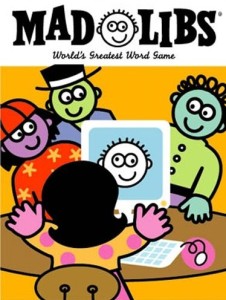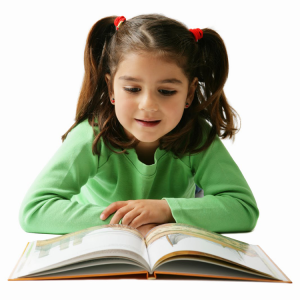How to Program Twitterbots as an Intro to Computer Science
 This lesson began with a quick discussion of Mad Libs. What are Mad Libs? How do you play Mad Libs? I was surprised to find that only about 5% of my middle school students had played Mad Libs. One student explained that, in Mad Libs, you are given a short story with blanks to fill with nouns, verbs, or whatever. When you read your finished Mad Lib, you (hopefully) get a funny, random story.
This lesson began with a quick discussion of Mad Libs. What are Mad Libs? How do you play Mad Libs? I was surprised to find that only about 5% of my middle school students had played Mad Libs. One student explained that, in Mad Libs, you are given a short story with blanks to fill with nouns, verbs, or whatever. When you read your finished Mad Lib, you (hopefully) get a funny, random story.
As a class, we discussed JavaScript, JSON, and Kate Compton's Tracery. We went to the Tracery Tutorial on Crystal Code Palace and began to familiarize ourselves with the JSON/Tracery "rules" (aka syntax). Like Mad Libs, there was a sentence with blanks (like #color# and #animal#) to be filled with colors, animals, or whatever.
{
"sentence": ["The #color# #animal# of the #natureNoun# is called #name#"]
, "color": ["orange","blue","white","black","grey","purple","indigo","turquoise"]
, "animal": ["unicorn","raven","sparrow","scorpion","coyote","eagle","owl","lizard"]
, "natureNoun": ["ocean","mountain","forest","cloud","river","tree","sky","sea","desert"]
, "name": ["Arjun","Yuuma","Darcy","Mia","Chiaki","Izzi","Azra","Lina"]
}
We took the example above (example 2 from Crystal Code Palace) and began to personalize it. We changed the "hashtags" (aka variables) and adapted the "lists" (aka arrays). We ended up with this...
{
"sentence": ["#name#, the #adj# #animal# from #place#"]
, "adj": ["fluffy","smart","invisible"]
, "animal": ["unicorn","duck","kitten"]
, "place": ["the ocean","Cabela's","Ohio"]
, "name": ["Caleb","Rover","Cartman"]
}
 On Crystal Code Palace, we could instantly see the results from our code.
On Crystal Code Palace, we could instantly see the results from our code.
- Cartman, the fluffy duck from Cabela's
- Caleb, the invisible duck from Ohio
- Rover, the fluffy unicorn from Ohio
- Rover, the smart duck from the ocean
- Cartman, the fluffy kitten from the ocean
The students worked individually creating their own sentences, adjectives, animals, places, and names. After school, I combined all of their JSON values (you can check it out on GitHub), created a Twitter account for our bot, and then posted the code on George Buckenham's Cheap Bots Done Quick. Soon, our Twitterbot was brainstorming book titles.
https://twitter.com/booktitlebot/status/645424665494745092
https://twitter.com/booktitlebot/status/645386928007839744
https://twitter.com/booktitlebot/status/645032078887780352
 The next day, we discussed what a "bot" is, what a "Twitterbot" is, and reviewed what our Twitterbot had been tweeting overnight. A few minutes later, the students split into pairs and began working on their own Twitterbots.
The next day, we discussed what a "bot" is, what a "Twitterbot" is, and reviewed what our Twitterbot had been tweeting overnight. A few minutes later, the students split into pairs and began working on their own Twitterbots.
Click here for the complete list of my students' Twitterbots
RECENT POSTS
- Adding Background Music to Puzzlescript Games
- Baby Zombie Chicken Jockey Java Minecraft Mod
- Raining Chickens Java Minecraft Mod
- Spawn a Pet Wolf Java Minecraft Mod
- Spigot Server for Java Minecraft Mods
- Python Classes to Javascript Classes
- JUnit Tests with Repl.it Teams for Education
- Canvas How to convert an old Quiz Question Bank to a new Quiz Item Bank
- Node Twitterbot Directions
- FogeyBot Thinks Twitter is the Worst
- Detecting Sentence Structure with Regex
- Game-based Learning Presentation
- Hello Jekyll
- Testing 123
- Grading Multi-Select Questions with Google Forms and Google Sheets
- Puzzlescript Rules
- Using Makey Makey to Teach Electricity
- Makey Makey + Scratch Video Game Projects
- Orbit Simulator
- Market game
- TwineFray: A Battle System for Twine
- Sundown
- Twine Games by Middle School Students
- Twine CSS
- Twine Music and Sound Effects from YouTube
- Twine Pictures, GIFs, and Background Images
- Twine Random Numbers
- Tutorial videos for Spreadsheet Functions and Formulas
- How to Program Twitterbots as an Intro to Computer Science
- Podcast Recommendations
- Coding Twitterbots with Middle School Students
- Educational Games on The Internet Archive
- Typing Games in Scratch
- Scratch Tutorial Videos
- Editing videos with Windows Movie Maker
- How to use iMovie for iPad
- Quick and easy DIY pressure plate switch for Makey Makey and Scratch
- Webcam Motion Pixel Art
- Flipped Classroom Scratch Programming Lessons
- BYOD Music Class Using OhioFi Games
- 3 Methods for Going Paperless in the Classroom
- Dodgeball Cat
- How to Automatically Republish a Google Forms Spreadsheet
- The Funeral, a comedy...? by Jon Kovach
- Polaroid cameras that use Fuji Packfilm
- How to Use Google Drive to Store High Scores for Twine Games
- Twine scripts and macros
- Twine style
- Twine logic
- Twine variables